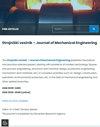亚音速喷射器与涡扇热力学模型性能的初步比较
IF 1.2
4区 工程技术
Q3 ENGINEERING, MECHANICAL
Strojniski Vestnik-Journal of Mechanical Engineering
Pub Date : 2020-05-20
DOI:10.5545/sv-jme.2019.6379
引用次数: 1
摘要
混合流动在工艺过程中是常见的,喷射器和涡扇都可以在具有不同能量势的流动之间产生相互作用。喷射器被广泛应用,其分析模型也被广泛提出。据作者所知,目前还缺乏关于涡轮风扇效率的研究。本文的目的是比较这些装置中的热力学过程。它们的效率是根据压缩率和夹带率进行比较的。提出了一种综合的喷射器和涡扇的一维亚音速热力学模型。在相同的初始条件下,用理想压缩焓差与理想膨胀焓差之比表示得到了定量指标。当初始条件等于所评估组件的等熵效率组合的数值(数值情况为0.16)时,两个设备具有相同的效率;在较低的初始条件下(数值情况为0.10),涡扇的吸入比提高了1.5倍,压缩效率提高了1.25倍;在较高的初始条件值(数值情况为0.28)下,喷射器效率更高。涡扇发动机的这种独特特性及其变化的性质可能对应于需要一定流动混合参数的工艺设备的特定应用领域。本文章由计算机程序翻译,如有差异,请以英文原文为准。
Preliminary Comparison of the Performance of Thermodynamic Models of the Subsonic Ejector and Turbofan
Flow-mixing is common in technological processes, and both ejectors and turbofans can produce an interaction between flows with different energy potentials. Ejectors have been extensively used, and their analytical models have been widely presented. To the best of the authors’ knowledge, there is a lack of studies exploring the efficiencies of turbofans. The goal of this paper is to compare thermodynamic processes in these devices. Their efficiencies are compared in terms of compression and entrainment ratios. A comprehensive one-dimensional subsonic thermodynamic models of the ejector and turbofan are presented. The quantitative indices are obtained for the same initial conditions expressed as the ratio of differences in enthalpies for ideal compression and ideal expansion. When initial conditions are equal to the numeric value of the combination of the isentropic efficiency of the evaluated components (numerical case 0.16), both devices have the same efficiencies; at lower initial conditions (numerical case 0.10), a turbofan’s entrainment ratio is 1.5 times and compression efficiency 1.25 times higher; at higher values of initial conditions (numerical case 0.28), the ejector is more efficient. Such distinctive characteristics of turbofans and the nature of their variation may correspond to the specific application areas of technological equipment that require certain flow-mixing parameters.
求助全文
通过发布文献求助,成功后即可免费获取论文全文。
去求助
来源期刊
CiteScore
3.00
自引率
17.60%
发文量
56
审稿时长
4.1 months
期刊介绍:
The international journal publishes original and (mini)review articles covering the concepts of materials science, mechanics, kinematics, thermodynamics, energy and environment, mechatronics and robotics, fluid mechanics, tribology, cybernetics, industrial engineering and structural analysis.
The journal follows new trends and progress proven practice in the mechanical engineering and also in the closely related sciences as are electrical, civil and process engineering, medicine, microbiology, ecology, agriculture, transport systems, aviation, and others, thus creating a unique forum for interdisciplinary or multidisciplinary dialogue.

 求助内容:
求助内容: 应助结果提醒方式:
应助结果提醒方式:


